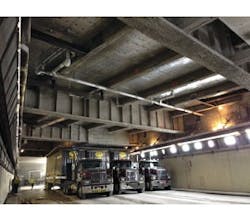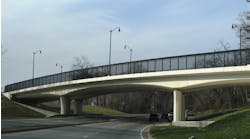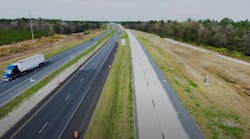The Hynes Convention Center is located in the heart of Boston’s historic Back Bay neighborhood.
Portions of the Hynes are located directly over I-90, the Massachusetts Turnpike. A 50-year-old cast-in-place concrete slab, suspended from the underside of the Hynes, serves as the ceiling for the westernmost 420 ft of the Prudential Center tunnel.
Maintenance of the tunnel ceiling beneath the Hynes is the responsibility of the building owner, the Massachusetts Convention Center Authority (MCCA), as stipulated in an easement agreement. On behalf of the owner, Simpson Gumpertz & Heger Inc. (SGH) performed rigorous annual inspections of the ceiling and ceiling-support system over many years to evaluate its condition and recommend repairs.
This article describes the planning that led to a safe and efficient removal of the 50-year-old slab. The owner, owner’s representative, engineers and construction manager focused their planning efforts into three primary phases of work: demolition-enabling work, early-phase demolition work and ceiling removal.
Ready for removal
This 50-year-old concrete ceiling provided both fire separation and acoustical separation between the tunnel and the Hynes; it spanned four eastbound and four westbound travel lanes above the turnpike. Two massive monolithic suspended slabs (a combined area more than 40,000 sq ft) formed the ceiling, separated by a single expansion joint. The turnpike alignment is skewed approximately 20° relative to the Hynes framing, and the ceiling was suspended from the Hynes first-floor framing by hangers spaced on a 10-ft grid. The Hynes first-floor framing consisted of wide-flange steel beams spaced at 10 ft on center spanning between deep plate girders spaced 30-ft apart. The vertical space between the suspended slab and the Hynes first floor is herein referred to as the interstitial space.
Together, through regular inspections and other related studies, the owner and SGH determined the ceiling had reached the end of its useful life and needed to be removed. Removing the ceiling would expose parts of the Hynes structure to environmental conditions that it had not encountered since it was built in the 1960s.
Select cut
Contractors accessed the interstitial space through a series of 2-ft by 3-ft doorways. Tight clearances between the Hynes’ steel-plate girders and suspended ceiling slab (between 4 in. and 18 in. of clearance) presented access challenges every 30 ft on center along the roadway. Such restrictions limited the contractor’s mobility in the interstitial space; crawling or rolling on moving-dollies was mandatory. In this restricted space, contractors installed insulation overhead (on the underside of the Hynes first-floor slab), installed spray-applied resistive material on the first-floor beams and girders, heat-traced and installed insulation on utilities, installed a 420-ft-long fire-rated concrete masonry wall to divide the tunnel bores and weatherproofed and insulated escalator pits.
While contractors executed the demolition-enabling work, SGH, the owner, and the owner’s representative (Tishman Construction Corp. of Massachusetts, a division of AECOM) planned for ceiling removal. Together, they evaluated several different demolition options including pulverizing, hydrodemolition and controlled saw cutting. After researching demolition methods and costs, SGH and the owner concluded that the risk of damaging the convention center structure or tunnel components during pulverizing was too great. Hydrodemolition was logistically challenging and too costly. Saw cutting provided the most desirable approach, as the process was controlled and was the least hazardous to the surrounding structures.
Initially, the Massachusetts Highway Department (MassDOT) constrained the project team to removing the ceiling at night during traffic lane closures. As such, SGH devised a plan under which the contractor would systematically cut the ceiling slab into a series of lane-wide pieces over closed traffic lanes and then remove the pieces while working adjacent to active traffic lanes. Prior to cutting, the contractor would install supplemental beams and additional hangers to support the saw-cut slab edges.
Half in advance
MCCA decided that a construction manager at-risk project delivery method was most suitable for this project, and the Massachusetts inspector general approved this approach. A year prior to ceiling removal, the owner engaged J.F. White Contracting Co. as the at-risk construction manager for the $8.5 million ceiling-removal project. During that year of planning, J.F. White provided SGH with valuable constructability and technical input, and the two parties worked closely to finalize a safe and efficient demolition plan.
Not long after J.F. White joined the project team, MassDOT lifted the constraint of removing the ceiling during nighttime lane closures. MassDOT granted the project team four full-bore weekend tunnel closures (with an additional contingency weekend), which consisted of two westbound weekend closures and two eastbound weekend closures. MassDOT dictated the time periods during which the contractor could work in order to coordinate with other active projects along the turnpike.
J.F. White immediately recognized the material savings and schedule opportunities that full-bore closures provide during round-the-clock weekend work. They proposed a revised saw-cutting plan under which more than half the saw cuts occurred in advance of the weekend closures, with the remainder deferred to the full-closure weekends. This revised scheme significantly reduced the quantity of additional temporary structural hangers and supplemental steel needed to support the existing slab at saw-cut edges. Later, during demolition weekends, the civil subcontractor would temporarily shore the precut concrete slab sections and complete the saw cutting.
Prior to saw cutting, iron workers from Saugus Construction Corp. installed supplemental steel beams and additional hangers in the interstitial space. Distributing the steel throughout the work area was no easy task, given the mobility constraints within the interstitial space. Steel pieces weighed as much as 600 lb, which the ironworkers maneuvered and installed by hand and in many cases worked delicately around critical utilities.
The contractor performed saw cuts along the tunnel walls and also across the full width of the roadway (parallel to the building framing), at approximately 30-ft intervals, during nighttime lane closures. The successful installation of supplemental steel and additional hangers, and the rapid completion of advanced saw cutting, allowed the contractor to optimize its ceiling-removal effort during the full-bore closures on the four predetermined weekends.
Four wide
As described above, MassDOT provided four full-bore closures during weekends in March and April 2014. Each closure consisted of a 55-hour window during which the contractor opened two highway crossovers and executed the traffic-management plan, which included one contraflow traffic lane in the active bore. During the weekend closure, the contractor shored portions of the suspended ceiling, performed the remaining saw cuts, lowered each of the ceiling segments and removed them from the tunnel, cleaned up the work areas and restored normal traffic patterns for the Monday morning commute.
J.F. White, with civil subcontractor LM Heavy Civil Construction (LMH), developed a simple yet elegant solution for both shoring the ceiling and removing the ceiling segments. This entailed parking four tractor-trailers side by side across the width of the tunnel bore. A steel frame with jacking legs sat on each trailer; each frame supported a 40-ft-long steel cargo container. The jacking legs could be individually controlled, which allowed LMH to lift the cargo container snug to the underside of the suspended ceiling with ease. With four shoring rigs in place, LMH performed the final saw cuts between the trucks to free the ceiling segments. Once LMH disengaged each lane-wide, 30-ft-long segment from the rest of the ceiling, they lowered the jacking frame to rest the loaded cargo container on the bed of the truck and then drove the shoring rig out of the tunnel to a staging area.
At the staging area, a pair of forklifts working in unison removed each segment from the shoring rigs and loaded them onto transport trailers. The shoring rigs then backed up in their lane and positioned themselves below the next 30-ft segment. Following this repetitive process, the four shoring rigs advanced steadily down the tunnel.
The contractor grappled with a steep learning curve during the first weekend of ceiling removal. The process of performing the final saw cuts, lowering a 30-ft piece of ceiling, offloading the piece and cycling back into position under the next piece initially took LMH approximately four and a half hours for each shoring rig. By the end of the weekend, however, they reduced that cycle to only three hours. In total, they achieved their weekend goal and removed 26 saw-cut segments (totaling approximately 8,100 sq ft) from the western half of the westbound tunnel bore.
LMH’s efficiency continued to improve throughout the second weekend. They removed the remaining 28 pieces from the westbound tunnel bore (totaling approximately 7,100 sq ft). Each shoring-rig cycle took approximately two and a half to three hours.
On the third weekend, LMH shifted their focus to the eastbound tunnel bore and further improved their efficiency by completing the scheduled ceiling removal approximately halfway through the weekend closure. Each shoring-rig cycle took approximately two hours on average, and then LMH removed a significant portion of ceiling originally scheduled for the fourth weekend. In total, LMH removed 52 pieces (totaling approximately 17,000 sq ft), which left only four 30-ft-long pieces for removal.
Despite the fast pace, LMH faced some challenges on the third weekend, which they quickly overcame. Just after midnight on Sunday morning, they encountered a large, low-clearance elevator pit spanning three travel lanes. The pit was so close to the suspended ceiling slab that they could not saw cut the slab over the lane lines. To work around this obstacle, they orchestrated a procedure more sophisticated than any other used during their demolition effort: Three crew members simultaneously operated the controls of three shoring rigs and lowered a three-lane-wide piece weighing 75,000 lb. Afterward, all three shoring rigs slowly drove out of the tunnel side by side to remove the massive piece.
The contractor’s accelerated ceiling removal during the third weekend eliminated the need for a fourth full-weekend closure. This resulted in a significant savings for the owner and dramatically reduced the impact on the traveling public. The contractor removed the final four pieces during a single night by working in a combination of closed lanes.
After months of intensive work and complicated coordination among several entities, the contractors safely removed the ceiling ahead of schedule, resulting in savings for the owner and a significant reduction in public impact. The collaborative partnership between the owner, the consulting engineers, the construction manager and the contractors allowed the team to work cohesively to solve technical and logistical challenges throughout the construction process. R&B



